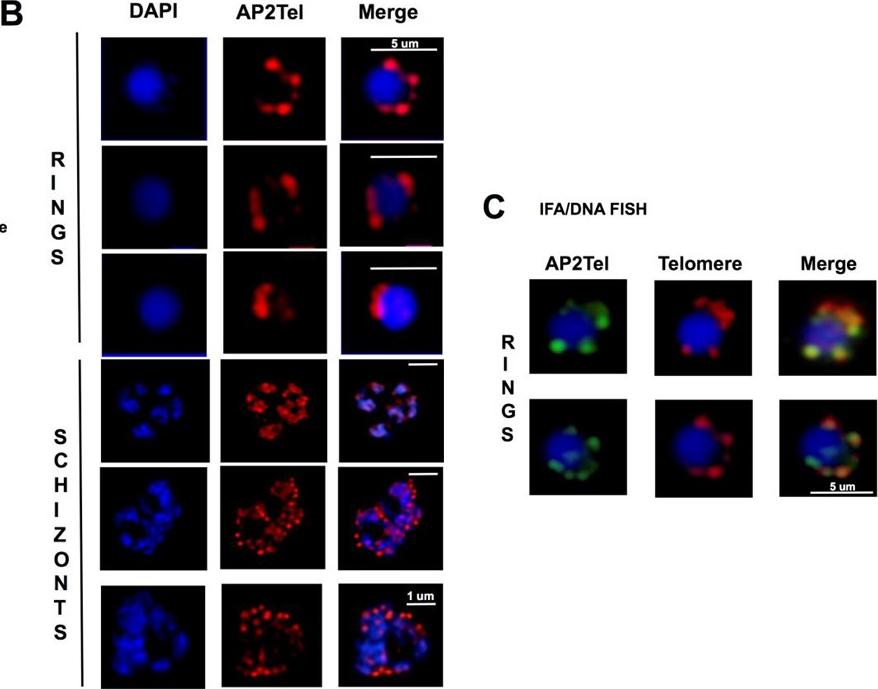PVX_114260 transcription factor with AP2 domain(s), putative
Disruptability [+]
| Species | Disruptability | Reference | Submitter | |
|---|---|---|---|---|
| P. berghei ANKA |
Possible |
RMgm-4114 | Imported from RMgmDB | |
| P. falciparum 3D7 |
Possible |
USF piggyBac screen (Insert. mut.) | USF PiggyBac Screen | |
| P. yoelii yoelii 17X |
Possible |
RMgm-4394 | Imported from RMgmDB | |
Mutant phenotypes [+]
| Species | Stage | Phenotype | Reference | Submitter |
|---|---|---|---|---|
| P. berghei ANKA | Asexual |
No difference |
RMgm-4114 | Imported from RMgmDB |
| P. yoelii yoelii 17X | Asexual |
No difference |
RMgm-4394 | Imported from RMgmDB |
| P. berghei ANKA | Gametocyte |
No difference |
RMgm-4114 | Imported from RMgmDB |
| P. yoelii yoelii 17X | Gametocyte |
No difference |
RMgm-4394 | Imported from RMgmDB |
| P. berghei ANKA | Ookinete |
No difference |
RMgm-4114 | Imported from RMgmDB |
| P. yoelii yoelii 17X | Ookinete |
No difference |
RMgm-4394 | Imported from RMgmDB |
| P. berghei ANKA | Oocyst |
Difference from wild-type |
RMgm-4114
Normal numbers of oocysts with a size comparable to wild type oocysts. 'Normal' sporozoite formation inside oocysts. Sporozoites inside oocysts are immotile. No release of sporozoites from oocysts. |
Imported from RMgmDB |
| P. yoelii yoelii 17X | Oocyst |
Difference from wild-type |
RMgm-4394
Normal numbers of oocysts. Sporozoite formation inside oocysts. No salivary gland sporozoites. Oocyst-derived sporozoites are not infective to mice. |
Imported from RMgmDB |
| P. berghei ANKA | Sporozoite |
Difference from wild-type |
RMgm-4114
Normal numbers of oocysts with a size comparable to wild type oocysts. 'Normal' sporozoite formation inside oocysts. Sporozoites inside oocysts are immotile. No release of sporozoites from oocysts. No (very few) salivary gland sporozoites. Mechanically released sporozoites are not infectious to mice. |
Imported from RMgmDB |
| P. yoelii yoelii 17X | Sporozoite |
Difference from wild-type |
RMgm-4394
Normal numbers of oocysts. Sporozoite formation inside oocysts. No salivary gland sporozoites. Oocyst-derived sporozoites are not infective to mice. |
Imported from RMgmDB |
Imaging data (from Malaria Metabolic Pathways)

PfAP2Tel localizes to telomeric foci at the nuclear periphery of blood stage parasites in vivo. B) Immunofluorescence assays were performed with anti-PfAP2Tel antibodies (red) in ring (R) and schizont (S) stage P. falciparum parasites. Nuclear DNA was stained with DAPI (blue). Confirmed nuclear distribution of PfAP2Tel. PfAP2Tel localized to the nuclear periphery as discrete foci; this pattern was especially evident in the schizont stage. C) Immunofluorescence assays with anti-PfAP2Tel antibodies (green) were combined with DNA Fluorescence in situ hybridization analysis of telomere ends (red) in ring (R) stage parasites. Nuclear DNA was stained with DAPI (blue). For B and C, scale bars indicate 5 μm (Rings) and 1 μm (Schizonts). PfAP2Tel co-localized with telomeric clusters at the nuclear periphery 80% of the time (N=50 cells). Overall, these results show that PfAP2Tel localizes to a compartment similar to telomeric clusters throughout the parasite blood stage life cycle.Sierra-Miranda M, Vembar SS, Delgadillo DM, Ávila-López PA, Vargas M, Hernandez-Rivas R. PfAP2Tel, harbouring a non-canonical DNA-binding AP2 domain, binds to Plasmodium falciparum telomeres. Cell Microbiol. 2017 [Epub ahead of print]
See original on MMPMore information
| PlasmoDB | PVX_114260 |
| GeneDB | PVX_114260 |
| Malaria Metabolic Pathways | Localisation images Pathways mapped to |
| Previous ID(s) | Pv114260 |
| Orthologs | PBANKA_1121800 , PCHAS_1121300 , PF3D7_0622900 , PKNH_1127300 , PVP01_1126600 , PY17X_1123200 |
| Google Scholar | Search for all mentions of this gene |